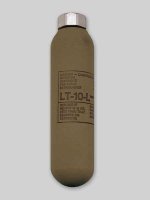vutch
Member
My grandfather tells stories about how they used to use dynamite as an all-purpose tool on the farm when he was younger. His uncle especially was the "dynamite man" around. They moved lots of stumps and rocks that way. Once in a while there would be a woodchuck or some other wildlife under the stumps when they blew. Needless to say, they came out in lots of small pieces. They still have problems around us with kids (or adults) finding dynamite that got shoved in the corner of an old shed years ago.
Also, I worked for a summer at a local company that makes fire extinguishers (Ansul is the name, you've probably seen it on many extinguishers). Anyway, the higher quality models store the dry chemical and the propellant gas (CO2 or nitrogen) seperately. The chemical is in the main tank, and the gas is stored in a small cylinder about 6-8 inches long under extremely high pressure (see photo). The top of the cylinder has a cap with a foil-type insert (how it holds that much pressure in, I dunno). When the extinguisher is used, a needle punctures this insert, allowing the gas to pressurize the dry chem tank. Well, I heard stories about some of the guys who got bored on the night shift and made a launcher with a piece of pipe with a nail in the bottom. They'd go out back by the river on breaks and drop the cartriges in the pipe so the nail punctured the cap. I guess they found some of those cartriges a ways away across the river!
Chris
Also, I worked for a summer at a local company that makes fire extinguishers (Ansul is the name, you've probably seen it on many extinguishers). Anyway, the higher quality models store the dry chemical and the propellant gas (CO2 or nitrogen) seperately. The chemical is in the main tank, and the gas is stored in a small cylinder about 6-8 inches long under extremely high pressure (see photo). The top of the cylinder has a cap with a foil-type insert (how it holds that much pressure in, I dunno). When the extinguisher is used, a needle punctures this insert, allowing the gas to pressurize the dry chem tank. Well, I heard stories about some of the guys who got bored on the night shift and made a launcher with a piece of pipe with a nail in the bottom. They'd go out back by the river on breaks and drop the cartriges in the pipe so the nail punctured the cap. I guess they found some of those cartriges a ways away across the river!
Chris
